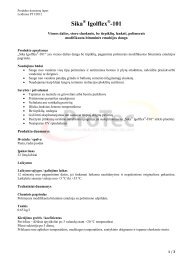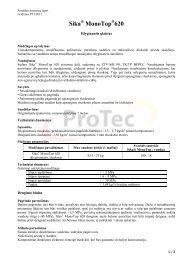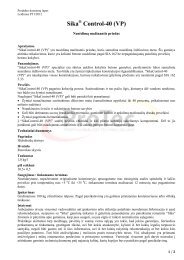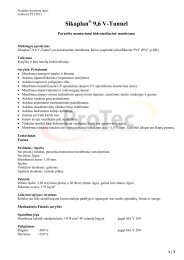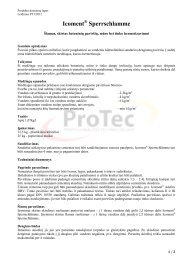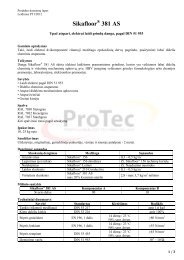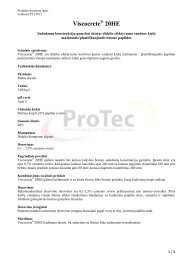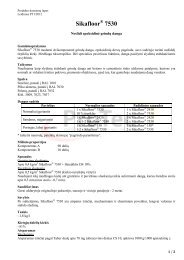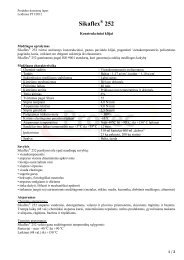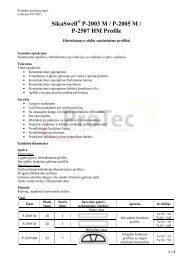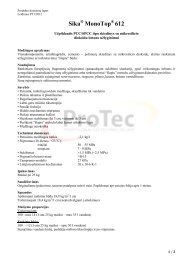Sikaflex Marine Handbook
Sikaflex® Marine Handbook - BlueMoment
Sikaflex® Marine Handbook - BlueMoment
- No tags were found...
Create successful ePaper yourself
Turn your PDF publications into a flip-book with our unique Google optimized e-Paper software.
C AULKINGL EVELLINGB EDDINGP ROTECTINGS EALING<strong>Sikaflex</strong> ® <strong>Marine</strong> <strong>Handbook</strong>B ONDINGG LAZINGBonding and Sealing Systems
High-tech, High bond.When the marine industry specifies a product, durability is highon its list of requirements. And for the boat owner, durability isan essential prerequisite for the smooth running of the vessel,the untroubled enjoyment of passengers and the sheer joy ofsailing. Whether at the wheel of a power boat or at the tiller ofa sailing yacht: there’s nothing quite like that feeling of freedomwhen you’re out there on your own, facing the elements ... orthat feeling of total tranquillity with only the horizon ahead andblue skies above. Times like this make your boat a possessionto cherish, and a valuable asset that you’ll want to protectagainst the elements for many years to come.Water leaks, in particular, can damage your prized possession,leaving unsightly marks along the hull and causing woodworkto rot and metal components to corrode. To avoid expensiverepair bills, watertight seals are absolutely essential.Deck caulkingFor timber decks that are completely watertight and weatherresistant, Sika has developed <strong>Sikaflex</strong> ® -290 DC. Extremely easyto use, this one-part polyurethane deck caulking compoundcan be sanded flush with the deck when cured to give abeautifully neat, clean finish.Different productsSame benefits.Sika pioneered the development of one-componentpolyurethanes for marine use. Our global technical resourceshave enabled us to produce a wide range of products, eachaimed at a specific marine application. Although the individualproduct characteristics vary, they all share the following features:– One component – no mixing necessary– Excellent gap–filling capabilities– Permanently elastic– Can be sanded and overpainted– Excellent non-sag properties– High solids content, low V.O.C.– Non-corrosive– For use above or below the waterline– All are specifically designed for marine use.SealingResistant to weathering, seawater and ultra-violet radiation,<strong>Sikaflex</strong> ® -291 is the perfect all-rounder: an all-purpose flexiblemarine sealant that bonds extremely well to all the standardmaterials used in boat construction. Its outstanding elasticityensures a durable, long-lasting seal.BondingJoints that are subject to extreme dynamic stresses require ahigh-strength elastic adhesive with good gap-filling capabilities.<strong>Sikaflex</strong> ® -292, with its excellent shock-absorbing andvibration-damping properties, has been specially developed tomeet these requirements in the punishing marine environment.When your safety may depend on it, only the best is goodenough.Bonding of plastic glazing panelsThis is an application that calls for a UV-resistant adhesive witha high degree of elasticity. <strong>Sikaflex</strong> ® -295 UV combines thenecessary elasticity with exactly the right consistency tomaintain the required bond line thickness, thus ensuring thatthermal movements in plastic glazing panels are absorbedprogressively, without undue build-up of stresses.Bonding and sealing of mineral glassDirect glazing of mineral glass requires a purpose designedadhesive with the right combination of application propertiesand performance characteristics. <strong>Sikaflex</strong> ® -296 is a fast curinghigh performance elastic polyurethane that is suitable for alltypes of mineral glass. It’s high UV resistance also makes itsuitable for backfilling and sealing operations.Bedding and bonding of panels and sheet materials.<strong>Sikaflex</strong> ® -298 is a viscous, full-bodied adhesive that has beenspecially formulated for the waterproof, flexible bonding oftimber strip decking, deck planking, plastic deck coverings andprefabricated timber deck panels. It is easy to work with, andgives professional results every time. The permanently elasticadhesive layer has a cushioning effect absorbing shocks andminimizing the transmission of impact sound.
ContentsIntroduction2Bonding and Sealing basics3Working with teak4Instructions forBonding and Caulking Teak DecksBonding of Deck Panels and Feature Decks5-78Bonding Anti-Slip Deck Coverings9Bonding of Anti-Slip Plates for Engine Rooms10Bonding Timber Components11Bedding and Sealing of Fittings and Hardware12Sealing of High-UV-Risk Areas13Bonding of Rub Rails and Fenders14Keel-to-Hull Joints and SealingBonding and Sealing Organic “Glass” (Plastic) Windows1516/17Bonding and Sealing Mineral Glass WindowsBonding of Decorative Panels and Work Surfaces18/1920Notes on SubstratesSika <strong>Marine</strong> Products Technical Data21/2223Cleaner, Primer and Adhesive Consumption Table24Primer Chart for Sika <strong>Marine</strong> Application25/26
<strong>Sikaflex</strong> ® in Boat Construction and Maintenance.Since the middle of the 17thcentury, when the industrialrevolution started, to the presentday, the process of joining haschanged dramatically.Nowadays the most advancedtechnology in marine is based onelastic adhesives.Historically no technique in shipbuilding has evolved as stronglyover the centuries as thetechnology of deck caulking.In the early days, woollen orcotton caulking yarn, incombination with bituminousmaterials, were employed.Nowadays the use of elastomericmaterials are common worldwide,especially as these elastic sealantsnot only fill the joint butadditionally seal and bond similarand dissimilar substratessimultaneously.Prevention of galvanic metalcorrosionCompensation for variable ratesof thermal expansionNoise and vibration dampeningElimination of localised stressesHigh shear and peel strengthsFreedom of designSavings on custom-made sealsand gasketsSimultaneous assembly andsealing operationOverpaintabilityHigh resistance to tearSimple one-component, humiditycuringsystem■ Prevention of deformation ofmetals due to thermal joiningprocesses (welding, etc.)Two-component and fast-curingversions for high initialstrength and fast handlingWeight- and cost-saving optionsAvailability in all consistenciesfrom fluid to non-sagPrevention of damage to thesubstrate, unlike with welding,drilling or riveting systemsJoining of painted componentsHigh durability for a longservice lifeHigh resistance to UV radiationProven resistance to seawaterand extreme climate conditionsDistortion-free joiningFlexible manufacturingproceduresHigh-impact resistanceNo single adhesive will meet allrequirements and few surfaces arecompletely ideal for bonding,hence Sika manufacture acomprehensive range of adhesiveand primer systems specifically formarine applications.If your requirement is not coveredin this handbook or you needdetails of a local supplier, pleasecontact Sika for further advice.The task of elastic bonding is tojoin, to waterproof, to dampensound, to insulate and to preventgalvanic corrosion. These are allproperties strongly associatedwith the marine environment,particularly in the manufacture andrepair of ships, boats and yachts.<strong>Sikaflex</strong> ® elastic bonding/sealingsystems allow for:Joining of similar and dissimilarmaterialsWider production tolerances2
Bonding and Sealing BasicsSika’s adhesives and sealants areworking materials which show goodaffinity for other surfaces. Their taskis to flow as a liquid onto and intothe contours of a surface and thentransform themselves into a solid,by developing both a physical and achemical bond with the substrate.Sika <strong>Marine</strong> Adhesive and SealantSystems can range from fluid liquidsto heavy thixotropic paste-likesystems, able to supply low-to-highstrengthvalues and cure to a highlyelastic or rigid bond. The ability ofthe adhesive or sealant to “wet” asurface is very critical in thedevelopment of a proper bond;solidification (curing) can take placethrough a physical or a chemicalreaction or through both at thesame time. Experience has shownthat chemically reactive adhesiveslike <strong>Sikaflex</strong> ® have the higheststrength, durability and resistanceto water.PreparationCorrect surface preparation is key tosuccessful bonding.Where there are weak orcontaminated surfaces, extensivepreparation maybe needed to ensurea perfect bond. Typical problems aredust, dirt, grease, oil, rust, flakingpaint, etc.The preparation selected will dependon the type of substrate (metal,plastic, paint, wood, etc.), theoperating conditions in service, thedegree of surface deterioration andthe practicalities of any particularinstallation. See the ‘notes onsubstrates’ in this manual or contactSika for details.Mechanical CleaningMechanical preparation, will berequired if, for example, corrosion isapparent, weak surface layersprevail, or surface degradation isshowing. The level of cleaning willbe determined by the type of surfaceand the degree of deterioration.Preparation techniques include theuse of abrasive nylon pads, abrasivepaper/fabric, wire brushing, abrasivewheels, and wet or dry grit blasting.Following mechanical treatment,additional cleaning with solventsmay also be required.Dedusting, DegreasingIf compressed air is used to removedust from surfaces, the air should befiltered to remove traces of oil.The use of vacuum cleaners is evenbetter for dust removal. Allnonporous surfaces must be cleanedprior to <strong>Sikaflex</strong> ® application.Only Sika-recommended cleaningmaterials should be used. Solvents,such as White Spirits and alcoholbased, are not recommended as theycan hinder cure or subsequentadhesion. Always use clean, lintfreewipes, and change them frequentlyto ensure that the contamination isremoved from and not redistributedonto the surface.Once clean, the substrates shouldbe left to completely dry beforeproceeding to the next operation.Note: Certain solvents, includingSika Cleaner ® -205, are notrecommended for use on absorbentsubstrates as unevaporated solventscan affect the curing mechanism of<strong>Sikaflex</strong> ® .PrimingPriming is a means of transforming asurface, either chemically, physicallyor both, into an ideal condition forsuccessful bonding, thus ensuringlong-term performance. The simplestform of priming is wiping theprepared surface with a conditioner(such as Sika Activator ® ) whichreacts with the surface providingimproved “wetting” characteristicsand more reactive sites.Porous and rough surfaces requirea primer with “film-forming”properties to re-profile the surface,producing a denser, more even bondline.Primers must always be allowed todry thoroughly before application ofthe <strong>Sikaflex</strong> ® adhesive. If left toolong, primed areas must be reappliedor reactivated. Minimum andmaximum drying times are given inthe primer chart in this guide.Primed surfaces should be protectedfrom contamination by dust, dirt,grease, vapours, moisture, etc., untilthe bond is formed.3
Working with TeakTeak has been used for hundreds ofyears as a decking material forships and boats because of itsanti-rot properties. Teak is abeautiful material in its unfinishedstate and, when caulked with<strong>Sikaflex</strong> ® , provides an elegantsolution for the anti-slipproperties required from a wet deck.Teak, however, is not a uniformmaterial; oil, and resin-content,as well as porosity, vary greatlyand the water content changesdepending on storage conditions,duration, temperature andhumidity.General ConditionsProper working conditions areessential for a successful result.Optimal results are obtainedunder constant or fallingtemperature conditions ofbetween +5°C and +25°C.Exposure to direct sunlight andrain during the operation andespecially during bonding orcaulking needs to be avoidedunder all circumstances.Exposure to the elements duringand following each step of theapplication procedure needs tobe prevented for at least 8 hours.Good ventilation in a well-organisedworking area areimportant factors for success.The Quality of the WoodTeak planks should showvertical, standing year rings.The core humidity content of thewood should ideally not exceed12%. Too high a level couldresult in excessive shrinkageleading to failure.Ideally, the humidity content of thetimber should correspond to theequivalent humidity expected inservice.Teak DecksIt is imperative that the width ofthe seams be directly related to thewidth of the teak planks and to thedepth of the seam; guidelines arelisted below.Should the joint dimensionsnot conform with ourrecommendations, please contactSika.plank width seam width seam depth(mm) (in) (mm) (in) (mm) (in)35 1 3 /8 4 5/32 4 to 5 5/32 – 3 /1645 1 3 /4 4 to 5 5/32 – 3 /16 6 1/450 2 5 to 6 3/16 – 1 /4 6 1/475 3 8 5/16 7 9/32100 4 10 13/32 8 5/16125 5 12 15/32 10 13/324
Instructions forBonding Teak DecksPreparation of SubstrateGlassfibre Reinforced Plastic (GRP) DecksApplication of <strong>Sikaflex</strong> ® -298Adhesive/Bedding Compound205206 G+P/215Heavily soiled surfaces should becleaned off first with a pure solvent(Sika ® Remover-208) to remove theworst of the soiling.Lightly abrade contact area with avery fine sanding pad. Remove dustwith a vacuum cleaner.Clean the substrate with Sika ® Cleaner-205, using a clean, lint-free rag orpaper towel. Change frequently!Drying time: minimum 10 minutes,maximum 2 hoursApply a thin, continuous coat of Sika ®Primer-206 G+P or Sika ® Primer-215,using a clean brush or felt applicator.Drying time: minimum 30 minutes,maximum 24 hours<strong>Sikaflex</strong> ® 298 will accommodate minor variations in deck levels.If prelevelling is required, contact Sika for details of the SikaTransfloor ® 352lightweight deck levelling compoundApply <strong>Sikaflex</strong> ® -298 to the previously prepared surface and spread over the area to becovered, using a spreader with 5 mm x 5 mm square notches at a quantity of up to 600g/m 2 . The exact quantity, however, depends on the regularity of the surface; care shouldbe taken that a continuous film of <strong>Sikaflex</strong> ® -298 is applied to avoid the potential risk ofwater penetration through the teak deck. (Figs. A, B)The bond face of the teak planks is de-oiled and primed as for deck caulking (see page 6).The teak planks must be positioned accurately within 20 minutes of applying the adhesiveand pressed firmly into place. It is therefore recommended that only a limited surfacearea be applied that can be covered with teak within the time available. (Fig. C)To fix and ensure the planks are embedded without voids, clamps, weights or screws(removable once the adhesive has set) must be used to secure the panel while theadhesive sets. Alternatively, the vacuum press method may be used.After approx. 24 hours the panels can carry their full service load and the temporaryfastenings can be removed.Timber DecksAbrade contact area on hull withsanding pad (80/100 grit) and removedust with a vacuum cleaner.Apply a thin, continuous coat of Sika ®290 DC Primer-290 DC, using a clean brush orfelt applicator.208Traces of uncured Sika adhesives or sealants may be removed with Sika ® Remover-208.On no account should other cleaning agents or Sika ® Cleaner-205 be used for thispurpose.Important: Please refer to the current Sika Technical Data Sheets and Safety Data Sheets obtainable through Sika or theirlocal distributor.Drying time: minimum 60 minutes,maximum 24 hoursAluminium and Steel DecksIf the deck is already coated with aprimer but adhesion cannot beassured or the primer is soluble inColma Cleaner, the primer must beremoved by gritblasting.If adhesion can be assured, thesurface should be cleaned with anappropriate aqueous cleaner andsubsequently washed.Fig. AEG 1Apply a continuous coat of twocomponentSika Icosit ® EG 1 to thesurface using a clean brush or roller ata consumption of 200 g/m 2 .Drying time:10ºC 48 h–14 days20ºC 24 h–14 days30ºC 14 h–14 daysFig. BFig. C5
Instructions forCaulking Teak DecksBefore caulking the deck, ensurethe seam width and depth meetsthe guidelines listed on page 4.Preparation of SubstrateSeamsWhen recaulking older decks, existingcaulking should be removed and theseams routed out to the requireddimensions.In order to achieve long-term adhesionof <strong>Sikaflex</strong> ® -290 DC to the sides of theseams, a meticulous preparation of theseams is required. All foreign materialmust be removed and the seams mustbe clean and dry prior to the applicationof the primer. Best results areobtained using a high-powered industrialvacuum cleaner. Pneumaticequipment should not be used unlessequipped with an oil separator as teakreadily absorbs oil. De-oiling of thesides is recommended and is performedusing a lint-free cloth wetted withacetone or MEK (Methyl Ethyl Ketone).The cloth must be replaced at regularintervals to avoid re-soiling of thesurfaces. Allow 10 minutes to flash off.Remember these solvents areflammable, so take properprecautions!PrimingPriming the planks is a vital step inthe process of caulking with<strong>Sikaflex</strong> ® -290 DC. Failure toobserve the priming proceduremight be detrimental to the finalquality of the seal and will impairthe longevity of the deck. Primingmay commence after thoroughcleaning and de-oiling of theplanks.Fig. AApply a thin, continuous coat of Sika ®Primer-290 DC to the seam edges.Sika ® Primer-290 DC can be brush or290 DCspray applied in one coat to the seamsides. To ensure that no areas aremissed, move the brush back andforth. Sika ® Primer-290 DC is a filmformer: The coating should thereforelook glossy, giving a “wet-look” evenwhen dry (Fig. A). Workingtemperature 5–35°C, RH: 75% max.Drying time: Protect the primed areaagainst dust and rain, and leave theprimer to dry for at least one hourbefore starting the deck caulkingoperation. The maximum allowabletime between priming and caulking isno more than 24 hours. If this periodis exceeded, repriming is required.Application of the BondBreaker Tape<strong>Sikaflex</strong> ® -290 DC caulking compoundis designed to absorb the lateralmovements of the teak planks as theyexpand and contract with changes inthe weather, the environment or dueto variations in the humidity contentof the teak. To ensure properperformance of the <strong>Sikaflex</strong> ® , it isimperative that adhesion to thebottom of the seam section beavoided at all cost. To ensure this, astrip of release tape is applied to thebottom of the seam after the primerhas dried. (Fig. B)Fig. B6
Instructions forCaulking Teak DecksApplication of<strong>Sikaflex</strong> ® - 290DCBefore any work commences ensurethe temperature of the wood does notexceed 25°C.In addition, the operating temperatureduring application should be constantor falling and ideally within the range of+5°C and +25°C.Apply <strong>Sikaflex</strong> ® -290 DC ensuring air isprevented from entering the seam byplacing the tip of the nozzle againstthe bottom and keeping the gun at anangle of 60°–90°. Always use a handgun or a piston-driven airgun.Continue to pull the nozzle along theseam so that the joint is filled behindthe nozzle always ensuring a constantmotion is maintained. (Figs. C,D)After application of <strong>Sikaflex</strong> ® -290 DCand before skinning occurs, tool theexcess material from the surface of thedeck using a slightly flexible spatula at45°. This ensures complete filling ofthe seam.Protect the caulked joints from rainand direct sunlight for a period of atleast 8 hours. Do not use excessmaterial from the spatula for fillingseams.<strong>Sikaflex</strong> ® -290 DC is ready for sandingafter 7 days.Important: Please refer to the current Sika Technical DataSheets and Safety Data Sheets obtainable through Sika ortheir local distributor.The Sanding ProcessFollowing 7 days curing the deck isready for sanding. Prior to that, however,excess cured <strong>Sikaflex</strong> ® -290 DCshould be removed with a sharpchisel or knife.This procedure will avoid excess pullon the edges of the seams during thesubsequent sanding operation. Foreffective sanding results use anindustrial sander. It is recommendedto begin with a medium (80)progressing to a 120 grit or finer.Suitable sanders are beltsanders, flatplate sanders or elastically suspendedsanders. Sanding should be along thedirection of the seams.The Finishing TouchAlthough we do not recommendthe application of a finish to theexterior teak deck, many boatowners prefer to apply a lacquerfinish to the deck after sanding.Generally great care should betaken as finishes contain solventsor plasticisers which can adverselyaffect the cured <strong>Sikaflex</strong> ® -290 DCor the drying of the lacquer.The following criteria shouldalways be taken into consideration:Never apply the lacquer finish touncured <strong>Sikaflex</strong> ® -290 DC.Waiting time of at least one monthbefore application of the finish isrecommended.The compatibility of the lacquershould be evaluated on a smallsample area of the teak deck beforeapplication.Rigid lacquers have a negativeeffect on the elasticity of the jointand may crack or cause loss ofadhesion of the <strong>Sikaflex</strong> ® -290 DCfrom the teak planks.MaintenanceIt is important to wet and rinsethe deck regularly with freshwater in order to prevent dryingout. In warm climates thisprocedure should be carried out ona daily basis. The occasional use ofa mild detergent (natural liquidsoap) diluted in water should bekept to a minimum. Bleach andaggressive chemical cleaners shouldnot be used.NotePrefabricated teak decks oftenconsist of a multilayer construction,e.g. they are made of wood ontowhich a fine layer of teak isbonded. The base wood mightconsist of various wood qualities;the pores in the “wood” aredifferent in structure and size,therefore the caulking compound isnot always in a position to expelthe air pockets from the poresduring caulking. As a result smallbubbles within the joint maysurface during caulking. To avoidthe development of these “air”bubbles, we recommend toolingthe joints using a smooth, slightlyflexible spatula at an angle of 45°,expelling air from the pores andallowing a perfect joint to developduring cure.Fig. CFig. D7
Instructions forBonding of Deck Panels and Feature DecksDescription of ApplicationIn modern boats, timber decking isfrequently constructed in the formof prefabricated panels laid overthe structural deck. This method isfavoured for reasons of cost.These panels generally consist of amarine grade, WBP-bondedplywood backing with strips ofteak or Oregon pine bonded orglued to the face. Alternatively,they may consist of teak plankingheld together by a few layers ofglass fibre sheet impregnated withepoxy resin. They are availableeither in standard board sizes or asmade-to-measure deck sections cutand machined to a template.Another type of prefabricatedpanel consists of teak plankingwith rubber jointing strips and noplywood backing.One-part elastic polyurethaneadhesives are ideal for bondingthese panels to the deck. One-partpolyurethanes are resistant to seawater, they possess excellent gapfilling properties, and noadditional mechanical fasteningsare needed. Once cured, theadhesive bond is extremely strong,permanently elastic and waterproof.Because it is waterproof andapplied to the whole surface of thedeck, the adhesive acts as anadditional skin to protect the deckfrom attack by the elements. As thedeck does not have to be drilled forscrews or bolts, there are no holesthrough which water couldpenetrate and cause damage.8Preparation of SubstrateGlass Reinforced Plastic (GRP) Decks205206 G+P/215Timber Decks290 DCHeavily soiled surfaces should becleaned off first with a pure solvent(Sika ® Remover-208) to remove theworst of the soiling.Lightly abrade contact area with avery fine sanding pad. Remove dustwith a vacuum cleaner.Clean the substrate with Sika ® Cleaner-205, using a clean, lint-free rag orpaper towel. Change frequently!Drying time: minimum 10 minutes,maximum 2 hoursApply a thin, continuous coat of Sika ®Primer-206 G+P or Sika ® Primer-215,using a clean brush or felt applicator.Drying time: minimum 30 minutes,maximum 24 hoursAbrade contact area on hull withsanding pad (80/100 grit) and removedust with a vacuum cleaner.Apply a thin, continuous coat of Sika ®Primer-290 DC, using a clean brush orfelt applicatorDrying time: minimum 60 minutes,maximum 24 hoursApplication of <strong>Sikaflex</strong> ® -298 Adhesive2081 <strong>Sikaflex</strong> ® -290 DC2 Feature deck panel3 <strong>Sikaflex</strong> ® -2984 Deck3142Aluminium or Steel Decks, Coated withTwo-Part Lacquer205Clean the substrate with Sika ® Cleaner-205, using a clean, lint free rag orpaper towel. Change frequently!Drying time: minimum 10 minutes,maximum 2 hoursEpoxy-Backed Deck Panels205215Heavily soiled surfaces should becleaned off first with a pure solvent(Sika ® Remover-208) to remove theworst of the soiling.Lightly abrade contact area with avery fine sanding pad. Remove dustwith a vacuum cleaner.Clean the substrate with Sika ®Cleaner-205, using a clean, lint-freerag or paper towel. Changefrequently!Drying time: minimum 10 minutes,maximum 2 hoursApply a thin, continuous coat of Sika ®Primer-215, using a clean brush or feltapplicator.Drying time: minimum 30 minutes,maximum 24 hoursFlat surfaces: <strong>Sikaflex</strong> ® -298. Inclined surfaces: <strong>Sikaflex</strong> ® -291Apply adhesive to previously prepared surface and spread over area to be covered, usinga spreader with 4 mm triangular notches. The bed thickness may vary depending on thethickness of any gap that needs to be filled (normally 1–2 mm corresponding to 1-2 litresof adhesive per m 2 )The deck panel must be positioned accurately within the tack free time of the adhesiveand pressed firmly into place.Clamps, weights or screws (removable once the adhesive has set) can be used to securethe panel while the adhesive sets. Alternatively, the vacuum press method may be used.After approx. 24 hours the panels can carry their full service load and the temporaryfastenings can be removed.Traces of uncured Sika adhesives or sealants may be removed with Sika ® Remover-208.On no account should other cleaning agents or Sika ® Cleaner-205 be used for this purpose.Important: Please refer to the current Sika Technical Data Sheets and Safety Data Sheets obtainable throughSika or their local distributor.
Instructions forBonding Anti-Slip Deck CoveringsDescription of ApplicationDeck coverings or mats ofsynthetic resin compositionprovide a safe, non-slip surface towalk on as well as protecting thedeck against damage and leaks.The use of a one-part polyurethaneadhesive maximises theeffectiveness of the coveringmaterial, facilitates installation andensures a professional finish.Proprietary deck coverings incommon use include:T B SAnti-slideTreadmaster Lay TechPolygripNautoflexNorament<strong>Marine</strong> Deck 2000One-part polyurethane adhesivesgive excellent results with theseproducts. Installation is simple andstraightforward, while the longterm performance characteristics ofthe adhesive offer a number ofsignificant benefits.Timber DecksAbrade contact area on hull withsanding pad (80/100 grit) and removedust with a vacuum cleaner.290 DCApply a thin, continuous coat of Sika ®Primer-290 DC, using a clean brush orfelt applicatorDrying time: minimum 60 minutes,maximum 24 hoursAluminium Decks,Coated with Two-Part LacquerClean the substrate with Sika ®Cleaner-205, using a clean, lint-free205rag or paper towel. Changefrequently!Drying time: minimum 10 minutes,maximum 2 hoursFor the preparation of othersubstrates, please refer to thePrimer Chart.Deck CoveringsThe covering material must be freefrom release agents or other mediaused in the production process. UseMEK, Colma Cleaner, or otherappropriate solvents recommendedby the manufacturer. Perform a smalltest to verify if the substrate isaffected by the solvent.On non-porous coverings, the side205that is to be bonded should becleaned with Sika ® Cleaner-205, usinga clean, lint-free rag or paper towel.Change rag frequently!Drying time: minimum 10 minutes,maximum 2 hoursIn the case of covering materials withan open-pore structure or texturedweave finish, the only preparationnecessary is to ensure that the side tobe adhered to is completely dust-free.Note: Due to the many variationsof deck coverings, a test to check foradhesion is always recommended.Preparation of Substrateand Deck CoveringsGRP DecksHeavily soiled surfaces should becleaned off first with a pure solvent(Sika ® Remover-208) to remove theworst of the soiling.Lightly abrade contact area with a veryfine sanding pad (Scotch Brite M 600).Remove dust with a vacuum cleaner.Clean the substrate with Sika ®205 Cleaner-205, using a clean, lint-freerag or paper towel. Change frequently!Drying time: minimum 10 minutes,maximum 2 hoursApplication of <strong>Sikaflex</strong>®-291/-298 Adhesive208Flat surfaces: <strong>Sikaflex</strong> ® -298. Inclined surfaces: <strong>Sikaflex</strong> ® -291Apply adhesive to previously prepared surface and spread over area to be covered, usinga spreader with 2 mm triangular notches. The layer thickness should be 0.5–1 mm approx.The covering material must be placed in position within 30 minutes of applying theadhesive, so adhesive should be applied only to an area large enough to receive the nextsection of covering.When the covering has been placed in position it should be rolled down with a rubberroller, working from the centre outwards to expel any trapped air and push any excessadhesive out to the edges, where it can be removed. It is essential to ensure no trappedair remains.Note: If the covering material is laid under tension, the edges must be held or suitablyweighted.Traces of uncured Sika adhesives or sealants may be removed with Sika ® Remover-208.On no account should other cleaning agents or Sika ® Cleaner-205 be used for this purpose.Important: Please refer to the current Sika Technical Data Sheets and Safety Data Sheets obtainable throughSika or their local distributor.9
Instructions forBonding of Anti-Slip Plates for Engine RoomsDescription of ApplicationAnti-slip plates used in technicalstorage rooms or in engine roomsare traditionally fixed by rivets orother mechanical fixings. Being inan area which is subjected to a lotof vibration, these soon becomeloose and a large amount of repairwork is usually required. The useof elastic bonding technologyallows a better distribution ofstresses, thus avoiding the need forrepair work (Fig.A). In addition,fixation and sealing of plates canbe achieved in a single operation.Preparation of SubstrateGRP Floor205206 G+P/215Heavily soiled surfaces should becleaned off first with a pure solvent(Sika ® Remover-208) to remove theworst of the soiling.Lightly abrade contact area with avery fine sanding pad. Remove dustwith a vacuum cleaner.Clean the substrate with Sika ® Cleaner-205, using a clean, lint-free rag orpaper towel. Change frequently!Drying time: minimum 10 minutes,maximum 2 hoursApply a thin, continuous coat of Sika ®Primer-206 G+P or Sika ® Primer-215,using a clean brush or felt applicator.Drying time: minimum 30 minutes,maximum 24 hoursSteel FloorMechanically clean the surface bygrit-blasting to SA 2.5. Remove dustwith a vacuum cleaner.Clean the substrate with Sika ®208 Remover-208, using a clean, lint-freerag or paper towel. Changefrequently!Drying time: minimum 10 minutes,maximum 2 hoursApply a continuous coat of SikaEG 1Icosit ® EG 1 (two-component,anticorrosion primer).Drying time : minimum 14 hours,maximum 96 hoursAluminium Anti-Slip PlateLightly abrade contact area with avery fine sanding pad. Remove dustwith a vacuum cleaner.1205Clean the substrate with Sika ® Cleaner-205, using a clean, lint-free rag orpaper towel. Change frequently!Drying time: minimum 10 minutes,maximum 2 hours32210 TApply a thin, continuous coat of Sika ®Primer-210 T, using a clean brush orfelt applicator.Fig. A1 Anti-slip plate2 <strong>Sikaflex</strong> ® -2923 Floor structure(GRP or steel)Drying time: minimum 30 minutes,maximum 24 hoursApplication of <strong>Sikaflex</strong> ® -292 AdhesivePlace spacers in position (thickness 2 mm, approximately 50 Shore A hardness). Thesecan be pressed into the adhesive once applied.For the preparation of othersubstrates, please refer to thePrimer Chart.Apply parallel rows of beads of <strong>Sikaflex</strong> ® -292 in an 8 mm x 10 mm triangular profile.Assemble components within 20 minutes of applying adhesive.Apply pressure with weights or other fastening aids to compress adhesive to the height ofthe spacers.Wait at least 24 hours before walking on the bonded plates.208Traces of uncured Sika adhesives or sealants may be removed with Sika ® Remover-208. Onno account should other cleaning agents or Sika ® Cleaner-205 be used for this purpose.Important: Please refer to the current Sika Technical Data Sheets and Safety Data Sheets obtainable throughSika or their local distributor.10
Instructions forBonding Timber ComponentsDescription of ApplicationIn yachts and pleasure craft, stairs,companion ways and handrails arefrequently made from tropicalhardwoods, chosen both for theirdurability and their attractiveappearance. The use of screws tofix such items may eventuallyimpair both their durability andtheir appearance, due to moistureingress via the screw holes. For thisreason, it is advisable to fixhardwood components withadhesives. The absence of screwholes prevents water from enteringand damaging the timber. This is ofparticular importance in theconstruction of accommodationladders.In addition, bonding offers otherbenefits. The adhesive layer helpsto absorb the sound of footstepsand cushion vibrations.The integrity of painted surfacescan be preserved without loss ofcorrosion protection, and thepotentially harmful effects ofmoisture penetration into GRP areeliminated.GRP205206 G+P/215Heavily soiled surfaces should becleaned off first with a pure solvent(Sika ® Remover-208) to remove theworst of the soiling.Lightly abrade contact area with avery fine sanding pad (80/100 grit).Remove dust with a vacuum cleaner.Clean the substrate with Sika ®Cleaner-205, using a clean, lint-freerag or paper towel. Changefrequently!Drying time: minimum 10 minutes,maximum 2 hoursApply a thin, continuous coat of Sika ®Primer-215 or Sika ® Primer-206 G+P,using a clean brush or felt applicator.Drying time: minimum 30 minutes,maximum 24 hoursStainless Steel, e.g. Ladders205210 THeavily soiled surfaces should becleaned off first with a pure solvent(Sika ® Remover-208) to remove theworst of the soiling.Lightly abrade contact area with avery fine Scotch-Brite pad. Removedust with a vacuum cleaner.Clean the substrates with Sika ®Cleaner-205, using a clean, lint-freerag or paper towel. Changefrequently!Drying time: minimum 10 minutes,maximum 2 hoursApply a thin, continuous coat of Sika ®Primer-210 T, using a clean brush orfelt applicator.Drying time: minimum 30 minutes,maximum 24 hoursApplication of<strong>Sikaflex</strong>®-292 Adhesive208Place elastic spacers in position(thickness 2 mm, approximately50 Shore A hardness).Apply <strong>Sikaflex</strong> ® -292 to theproposed bond area using anotched spreader (4 x 4 mm) overthe face of the joint.Assemble components within 20minutes of applying adhesive.Apply pressure with clamps orother fastening aids to compressadhesive to the height of thespacers. Excess adhesivesqueezed out around the jointshould be trimmed off with a softplastic spatula.Note: Do not apply excessiveclamping pressure. If screws areused for additional security, theseshould only be tightened initiallyto secure the components whilethe adhesive sets. Leaveassembly for 24 hours beforetightening screws.Traces of uncured Sika adhesivesor sealants may be removed withSika ® Remover-208. On noaccount should other cleaningagents or Sika ® Cleaner-205 beused for this purpose.Clamps and other fastening aidscan be removed after 12 hours.Full service strength is attainedafter approximately 7 days.Important: Please refer to the current SikaTechnical Data Sheets and Safety Data Sheetsobtainable through Sika or their local distributor.Preparation of SubstrateUntreated Timber (Teak, Mahogany)Abrade contact area on hull withsanding pad (80/100 grit) and removedust with a vacuum cleaner.Timber, Aluminium or Steel Coated with Two-Part Lacquer205Clean the substrates with Sika ®Cleaner-205, using a clean, lint-freerag or paper towel. Changefrequently!For the preparation of othersubstrates, please refer to thePrimer Chart.290 DCApply a thin, continuous coat of Sika ®Primer-290 DC, using a clean brush orfelt applicator.Drying time: minimum 10 minutes,maximum 2 hoursGRPDrying time: minimum 60 minutes,maximum 24 hours11
Instructions forBedding and Sealing of Fittings and HardwareDescription of ApplicationAll kinds of deck fittings andhardware need to be securely fixedand totally watertight. Some ofthese fittings are also subjected, onoccasion, to very high forces andtorsional stresses.Poorly sealed joints can eventuallyresult in serious damage such asmetal corrosion, osmosis andwater leaks causing damage tointerior furnishings and fittings.Bedding and SealingFittings Subject to HighMechanical StressesDeck fittings such as chain plates,winches and guide rollers have toabsorb very high dynamic stresses.A high-performance product, suchas <strong>Sikaflex</strong> ® -292, should be used inconjunction with additionalmechanical fixation for thispurpose.pulled up tight. To prevent thishappening, shims approx. 1 mmthick should be threaded over thescrews on the underside of thefitting to act as spacers. The screwholes themselves should also befilled with sealant prior to fixing.Spacing the fitting off the deck by2–3 mm also facilitates its removalat a later date, when a cutting wireor knife blade can be insertedbetween the base of the fitting andthe deck.Preparation of SubstrateTimber DecksAbrade contact area on hull withsanding pad (80/100 grit) and removedust with a vacuum cleaner.Apply a thin continuous coat of Sika ®290 DC Primer-290 DC, using a clean brush orfelt applicatorDrying time: minimum 60 minutes,maximum 24 hoursBronze, Brass or Stainless Steel FittingsClean the substrate with Sika ® Cleaner-205 205, using a clean, lint-free rag orpaper towel. Change frequently!Drying time: minimum 10 minutes,maximum 2 hoursApply a thin, continuous coat of Sika ®210 T Primer-210 T, using a clean brush orfelt applicator.Drying time: minimum 30 minutes,maximum 24 hoursAluminium FittingsLightly abrade contact area with avery fine sanding pad (Scotch-Brite M600).Clean the substrate with Sika ®Cleaner-205, using a clean, lint-free205rag or paper towel. Change ragfrequently!Drying time: minimum 10 minutes,maximum 2 hoursApply a thin, continuous coat of Sika ®210 TPrimer-210 T, using a clean brush orfelt applicator.Drying time: minimum 30 minutes,maximum 24 hoursBedding and SealingFittings Subject toMinimal MechanicalStressesDeck fittings such as ventilators,cover strips, etc. need to be sealedagainst entry of water, but theyare not subject to high tensilestresses. Such fittings can beeffectively bedded and sealed with<strong>Sikaflex</strong> ® -291.Important Note:It is vital to ensure that theadhesive is not simply squeezed outagain when the fixing screws areAluminium Decks (Painted)205Clean the substrate with Sika ®Cleaner-205, using a clean, lint-freerag or paper towel. Changefrequently!Drying time: minimum 10 minutes,maximum 2 hoursFor the preparation of othersubstrates, please refer to thePrimer Chart.Application of <strong>Sikaflex</strong>®-291/292 Adhesive<strong>Sikaflex</strong> ® -291or 292 should be applied to the deck and the fixing screw holes in a bead ofthe required thickness. The fitting is then pressed into position.The fixing screws should be tightened sufficiently to pull the fitting down on the spacers,but no more. Use a plastic spatula to remove excess sealant squeezed out around theedges. After 24 hours tighten the screws.Traces of uncured Sika adhesives or sealants may be removed with Sika ® Remover-208.208 On no account should other cleaning agents or Sika ® Cleaner-205 be used for thispurpose.Important: Please refer to the current Sika Technical Data Sheets and Safety Data Sheets obtainable through Sika or theirlocal distributor..12
Instructions forSealing of High-UV-Risk AreasInstructions forPerforming UV-ResistantSealing ApplicationsDescription of ApplicationOn modern ships, yachts and motorboats the joints between differentmaterials must be sealed to protectagainst water ingress, corrosion, etc.In addition, they must also supplyan aesthetic finish to the joint.High-performance sealant joints canbe made with conventionalone-component, polyurethane-basedsystems, which, due to theirexcellent adhesion to varioussubstrates, allow permanentelasticity and resistance againstwater ingress and corrosion.Conventional polyurethane sealants,however, exhibit some sensitivity toUV radiation. After very prolongedperiods of exposure the joint surfacemay exhibit slight degradation. Thisdoes not detract from the sealingproperties, as it is only a surfaceeffect. If a durable surface aspect isrequired, the use of a specificallyformulated, UV-resistantpolyurethane should be considered.Most ships and particularly luxuryyachts and vessels require a largenumber of such joints and hencerequire the use of a high-durabilitysealant. <strong>Sikaflex</strong> ® -295 UV (Fig. A),in white or black, provides excellentresistance against solar UV radiationand sea water attack, the whitegrade also providing superior nonyellowingcharacteristics.<strong>Sikaflex</strong> ® -295 UV is thereforeparticularly suited for sealing suchareas as deck fittings, hatches,window rebates, etc.Preparation of SubstrateWood290 DCAbrade contact area on hull withsanding pad (80/100 grit) and removedust with a vacuum cleaner.Apply a thin continuous coat of Sika ®Primer-290 DC, using a clean brush orfelt applicatorDrying time: minimum 60 minutes,maximum 24 hoursAluminium and Stainless Steel205Clean the substrate with Sika ® Cleaner-205, using a clean, lint-free rag orpaper towel. Change frequently!Drying time: minimum 10 minutes,maximum 2 hoursAcrylic and Polyurethane-Based Paint205GRP205206 G+P/215Clean the substrate with Sika ® Cleaner-205, using a clean, lint-free rag orpaper towel. Change frequently!Drying time: minimum 10 minutes,maximum 2 hoursLightly abrade contact area with avery fine sanding pad. Remove dustwith a vacuum cleaner.Clean the substrate with Sika ® Cleaner-205, using a clean, lint-free rag orpaper towel. Change frequently!Drying time: minimum 10 minutes,maximum 2 hoursApply a thin, continuous coat of Sika ®Primer-206 G+P or Sika ® Primer-215,using a clean brush or felt applicator.Drying time: minimum 30 minutes,maximum 24 hoursFor the preparation of othersubstrates, please refer to thePrimer Chart for Sika <strong>Marine</strong>Applications.Fig. AApplication of<strong>Sikaflex</strong>®-295 UV Adhesive208<strong>Sikaflex</strong> ® -295 UV should beapplied to the joint in a bead ofthe required dimensions takingcare to avoid air entrapment.Use a plastic spatula to removeexcess sealant squeezed outaround the edges. Tool to asmooth finish within thetack-free time of the sealantusing Sika ® Tooling Agent N.Traces of uncured Sikaadhesives or sealants may beremoved with Sika ® Remover-208. On no account shouldother cleaning agents or Sika ®Cleaner-205 be used for this.purpose.Important: Please refer to the current SikaTechnical Data Sheets and Safety Data Sheetsobtainable through Sika or their local distributor.Note: Instructions for the use ofspecifically formulated, UV-resistantproducts such as <strong>Sikaflex</strong> ® -295 UVdo not apply in situations whereUV radiation may directly attackthe bond faces, e.g. transparentsubstrates. Please consult thespecific instructions for theseapplications. <strong>Sikaflex</strong> ® -295 UV isnot suitable for teak deck caulking.13
Instructions ForBonding of Rub Rails and FendersInstructions for BondingRub Rails to HullDescription of ApplicationRub rails and fenders are designedto protect the hull of a ship or boatagainst damage. They act as abumper to absorb impacts andscrapes, and the more elastic theyare, the more effectively they canperform this function.Their elastic behaviour variesaccording to the type of materialused. The shock-absorbingperformance of the rub rail issignificantly improved by the useof an elastic adhesive joint. Thisaffords maximum protection to thehull.Rub rails of conventional timber,PVC or polyurethane constructioncan be securely bonded to marinehulls using <strong>Sikaflex</strong> ® -292. Theresulting elastic joint helps toabsorb most of the shear andtensile stresses to which rub railsare subjected when a vessel isdocking or casting off.In the case of rub rails securedwith screws, a similar effect can beobtained by backfilling the railprofile with <strong>Sikaflex</strong> ® -291, a highlyelastic polyurethane sealant. Aswell as absorbing torsionalstresses, this also seals the screwholes and prevents the ingress ofwater or dirt behind the rub rail.Preparation of SubstrateGRP Hulls205206 G+P/215Heavily soiled surfaces should becleaned off first with a pure solvent(Sika ® Remover-208) to remove theworst of the soiling.Lightly abrade contact area with avery fine sanding pad. Remove dustwith a vacuum cleaner.Clean the substrate with Sika ®Cleaner-205, using a clean, lint-freerag or paper towel. Changefrequently!Drying time: minimum 10 minutes,maximum 2 hoursApply a thin, continuous coat ofSika ® Primer-206 G+P or Sika ®Primer-215, using a clean brush orfelt applicator.Drying time: minimum 30 minutes,maximum 24 hoursFinished Painted Hulls of Aluminium orSteel, Coated with Two-part Lacquer205Clean the substrate with Sika ®Cleaner-205, using a clean, lint-freerag or paper towel. Changefrequently!Drying time: minimum 10 minutes,maximum 2 hoursTimber Rub Rails290 DCAbrade contact area on hull withsanding pad (80/100 grit) and removedust with a vacuum cleaner.Apply a thin, continuous coat of Sika ®Primer-290 DC, using a clean brush orfelt applicatorDrying time: minimum 60 minutes,maximum 24 hours.Moulded PVCor Polyurethane Rub Rails205The bond face of the rub rails must befree from mould release agents orother chemical contaminants. Alltraces of such substances must beremoved prior to proceeding.Abrade the bond face of the rub railwith coarse sand paper (60/80grit) tokey the surface.Clean the substrate with Sika ®Cleaner-205, using a clean, lint-freerag or paper towel. Change ragfrequently!Drying time: minimum 10 minutes,maximum 2 hoursApplication of <strong>Sikaflex</strong> ® -292/291 Adhesive/SealantPlace elastic spacers in position (thickness 2 mm, approximately 50 Shore A hardness).Apply <strong>Sikaflex</strong> ® -292 (or <strong>Sikaflex</strong> ® -291 if rub rails are to be secured using additionalmechanical fixation) in an 8 mm x 10 mm triangular bead to the proposed bond area.Assemble components within 20 minutes of applying adhesive.Because of the variable composition of rubrails, an adhesivon test is advised prior toinstallation.Press the rub rail into place, either directly onto the face of the hull or fitted over the coreprofile. Use clamps, etc. to hold the rub rail in position while the adhesive sets. If the rubrail is to be secured with mechanical fixings, any holes should also be filled with adhesive.Clamps and other fastening aids can be removed after 24 hours.Full service strength is attained after approximately 7 days.208Traces of uncured Sika adhesives or sealants may be removed with Sika ® Remover-208. Onno account should other cleaning agents or Sika ® Cleaner-205 be used for this purpose.14Important: Please refer to the current Sika Technical Data Sheets and Safety Data Sheets obtainable through Sika or theirlocal distributor.
Instructions ForKeel-to-Hull Joints and SealingDescription of ApplicationThe joint between keel and hull issubjected to very high stresses,particularly when a boat is undersail or if it runs aground.This critical joint must be designedand executed with great care towithstand these stresses.The joint between keel and hull isparticularly prone to leaks, whichmanifest themselves in the form ofrust streaking and staining on thekeel when the boat is removedfrom the water. The use of<strong>Sikaflex</strong> ® in conjunction with themechanical fixings prevents waterpenetration and improves stressdistribution.Preparation of SubstrateAluminium HullsHeavily soiled surfaces should becleaned off first with a pure solvent(Sika ® Remover-208) to remove theworst of the soiling.Lightly abrade contact area with avery fine sanding pad. Remove dustwith a vacuum cleaner.Clean the substrate with Sika ®Cleaner-205, using a clean, lint-free205rag or paper towel. Change ragfrequently!Drying time: minimum 10 minutes,maximum 2 hoursApply a thin, continuous coat of Sika ®Primer-210 T, using a clean brush or210 Tfelt applicator.Drying time: minimum 30 minutes,maximum 24 hoursGRP HullsHeavily soiled surfaces should becleaned off first with a pure solvent(Sika ® Remover-208) to remove theworst of the soiling.Lightly abrade contact area with avery fine sanding pad. Remove dustwith a vacuum cleaner.Clean the substrate with Sika ®205Cleaner-205, using a clean, lint-free206 G+P/215Timber Hulls290 DCrag or paper towel. Change ragfrequently!Drying time: minimum 10 minutes,maximum 2 hoursApply a thin, continuous coat of Sika ®Primer-206 G+P or Sika ® Primer-215,using a clean brush or felt applicator.Drying time: minimum 30 minutes,maximum 24 hoursAbrade contact area on hull withsanding pad (80/100 grit) and removedust with a vacuum cleaner.Apply a thin, continuous coat of Sika ®Primer-290 DC, using a clean brush orfelt applicatorDrying time: minimum 60 minutes,maximum 24 hoursSteel Hulls, Coated with Two-part CorrosionProtection Coating205Clean the substrate with Sika ®Cleaner-205, using a clean, lint-freerag or paper towel. Change ragfrequently!Drying time: minimum 10 minutes,maximum 2 hoursFor the preparation of othersubstrates, please refer to thePrimer Chart.Application of <strong>Sikaflex</strong>®-292 AdhesivePlace elastic spacers in position (thickness 10 mm, approximately 50 Shore A hardness).Fig. AApply <strong>Sikaflex</strong> ® -292 in 20–25 mm high triangular profiles. Each bead must form acontinuous, closed ring, with no gaps. The same applies to the beads around the bolt holes.Important Note: The bond faceon the keel and hull must also bewiped down with Sika ® Cleaner-205. In the case of lead keels, thecontact area must additionally begiven a coat of two-part epoxyresin protective paint.Drying time: 1 day minimum.208The keel is then lifted into position, observing carefully the open time of <strong>Sikaflex</strong> ® -292 andpulled up on the keel bolts as far as the spacer blocks. The adhesive that is squeezed out ofthe joint can be tooled to a smooth finish.After three or four days, the keel bolts can be tightened to their full torque rating. Theadditional pressure thereby exerted on the adhesive, gives the joint between keel and hullthe required degree of torsional stiffness. When the adhesive has fully hardened, the sealedjoint can be overpainted in the normal way with any good quality anti-fouling paint. Thesealed joint absorbs the dynamic stresses generated in this area and forms a totallywatertight bond between keel and hull.Traces of uncured Sika adhesives or sealants may be removed with Sika ® Remover-208.On no account should other cleaning agents or Sika ® Cleaner-205 be used for this purpose.Important: Please refer to the current Sika Technical Data Sheets and Safety Data Sheets obtainable throughSika or their local distributor.15
Instructions forBonding and Sealing “Organic Glass” (Plastic)WindowsDescription of ApplicationMost of the plastic glazingmaterials used in boat building areeither clear acrylic sheet (PMMA),widely marketed under tradenames such as “Perspex” and“Plexiglas” (the lattermanufactured by Röhm and Haas),or polycarbonate (PC), marketedby Röhm and Haas as“Makrolon” and by GeneralElectric as “Lexan”.All plastic glazing products possesscertain characteristics that must beclearly understood before theseproducts are installed or bondedwith adhesives. In general,incorrectly installed plastic glazingpanels are prone to stress cracking,which may be aggravated by theuse of certain adhesives.Plastic glazing products have ahigher coefficient of thermalexpansion than conventional glass.Therefore, when designing glazinginstallations, an expansion gap ofat least 5 mm (see edge sealingpage 17) all round must beincorporated between the windowrebate and the plastic glazing panelto accommodate thermalmovement. Similarly, any clearanceholes for fixing screws must bedrilled oversize, i.e. larger than theactual diameter of the screw shank.To minimise the risk of stresscracking, flat sheets of plasticglazing material should be installed16completely flat; they should not beforced to take up a curvature bythe use of mechanical fastenings.When the design calls for curvedglazing panels, these should beprefabricated to order and properlytempered by a specialist supplier toensure a stress-free installation.As many varieties of organic glassexist it is recommended to ensurethat the specific grade selected issuitable for use with<strong>Sikaflex</strong> ® -295 UV. For furtherdetails contact Sika.minimal adhesive thickness,t (mm)2 4 6 8 10ok0 0,5 1 1,5 2Largest dimension of the window (m)14521 Flange2 Window3 <strong>Sikaflex</strong> ® -295 UV4 <strong>Sikaflex</strong> ® -295 UV5 Sika ® UV Shielding Tapetoo small3tPreparation of SubstrateGRP Frame205206 G+P/215Lightly abrade contact area with avery fine sanding pad. Remove dustwith a vacuum cleaner.Clean the substrate with Sika ® Cleaner-205, using a clean, lint-free rag orpaper towel. Change frequently!Drying time: minimum 10 minutes,maximum 2 hoursApply a thin, continuous coat of Sika ®Primer-206 G+P or Sika ® Primer-215,using a clean brush or felt applicator.Drying time: minimum 30 minutes,maximum 24 hoursAnodised Aluminium Frame205210 TLightly abrade surface with ScotchBrite M 600, clean with Sika ® Cleaner-205, using a clean, lint-free rag orpaper towel. Change frequently!Drying time: minimum 10 minutes,maximum 2 hoursApply a thin, continuous coat of Sika ®Primer-210 T, using a clean brush orfelt applicator.Drying time: minimum 30 minutes,maximum 24 hoursPMMA / PC Glazing PanelsMask off perimeter bond area withmasking tape. Abrade bond area withabrasive paper or Scotch-Brite.205209Clean the substrate with Sika ® Cleaner-205, using a clean, lint-free rag orpaper towel. Change frequently!Drying time: minimum 10 minutes,maximum 2 hoursApply a continuous coat of Sika ®Primer-209, using a clean brush or feltapplicator.Drying time: minimum 30 minutes,maximum 24 hoursTimber or Aluminium Frame Coatedwith Two-Part Lacquer205Clean the substrate with Sika ® Cleaner-205, using a clean, lint-free rag orpaper towel. Change frequently!Drying time: minimum 10 minutes,maximum 2 hoursRefer to Sika ® primer chart for other substrates.
Instructions forBonding and Sealing “Organic Glass” (Plastic)WindowsApplication of <strong>Sikaflex</strong> ® -295 UV AdhesivePlace spacers in position. Depending on the size of the glazing panel, the thickness of thespacer should be chosen accordingly; approximately 30 Shore A hardness (see diagrampage16).Apply <strong>Sikaflex</strong> ® -295 UV to the frame rebate or glazing panel using a triangular nozzle ofbead width 10 mm minimum.Assemble components within 20 minutes of applying adhesive.Fig. BTo prevent slip down of vertical glazing panels, additional spacers (wood or plastic) mustbe placed in the lower rebate during installation. After curing, these must be removed.The rebate gap must be a minimum of 5 mm (see diagram below).Clamps and other fastening aids can be removed after 24 hours. After this time, theexpansion gap between glazing panel and rebate can be filled and sealed with <strong>Sikaflex</strong> ® -295 UV. This should be done only when the glazing adhesive has reached full cure. Thissealant joint can be tooled to a smooth finish using Sika ® Tooling Agent N. This must becarried out before skinning of the sealant.208Traces of uncured Sika adhesives or sealants may be removed with Sika ® Remover-208.On no account should other cleaning agents or Sika ® Cleaner-205 be used for thispurpose.Apply cover strip or Sika ® UV Shielding Tape to cover the bondline in accordance withSika recommendation.Important: Please refer to the current Sika Technical Data Sheets and Safety Data Sheets obtainable throughSika or their local distributor.Fig. CProtection of the BondAs with conventional glass, plasticglazing panels generally do notprotect the adhesive face fromdamage by UV radiation.Therefore, the bond face must beprotected from direct sunlight viaone of the methods recommended.Minimum Recommendations for UV Protection of the Bonddd=Thickness ofthe window3O=d1√2(n12 –1)O = Overlap1 UV protection2 <strong>Sikaflex</strong> ® -295 UV3 Window12External cover strip ofappropriate dimensionsSika ® UV Shielding Tape ofappropriate dimensionsn 12 = Refraction indexfor window glassSika RuleO=2xdExample: if d=8mm, the overlapshould be at least 16mm.Edge Sealing of WindowCommonly, the edge of thewindow will be cosmeticallyfinished with <strong>Sikaflex</strong> ® materials.The preparation of the surfacesmust be identical to that used forbonding. Edge sealing both ensuresthe prevention of standing wateron or near the bond and helpscosmetically finish the window.For plastic window panels<strong>Sikaflex</strong> ® -295 UV must be used inaccordance with the diagram.Minimal joint width (mm)4 8 12 16oktoo small0 1 2 3Largest window dimension (m)17
Instructions forBonding and Sealing Mineral Glass WindowsDescription of ApplicationDimensioning of AdhesiveThe direct glazing of mineral glass(toughened security glass) intoframes or directly into the hull ordeck, requires a full understandingof all the important principlesinvolved.and SealantThe dimensioning of the adhesiveand joint geometry must be carriedout in accordance with Sika’sbasic rules of calculation. If deckmovement is negligible thefollowing dimensions are132451324recommended.1 Mineral glass2 Ceramic coating3 <strong>Sikaflex</strong> ® -2964 Flange1 Mineral glass2 Ceramic coating3 <strong>Sikaflex</strong> ® -2964 Flange5 Edge ProtectionIt is essential that the glass meet allthe demands and standardsrequired for the intendedapplication. For insulation glass,total bonding consistency must beensured through the complete useof <strong>Sikaflex</strong> ® adhesives for all theinstallation, i.e. no silicones.The polyurethane adhesive bondface must also be protected againstGlass Window DimensioningJoint widthMinimal joint width (mm)4 8 12 16oktoo small0 1 2 3Largest window dimension (m)Glass Window DimensioningAdhesive thickness,tMinimal adhesive thickness,t (mm)4 6 8 10oktoo small0 1 2 3alumimiumSteelLargest dimension of the glass (m)UV radiation. This may beachieved by several means:Using a black, ceramic coatedborder with a light transmission ofless than 0.01% (measured withGretag D 200 visible range). Or byusing an overlapping trim (plasticJoint widthJoint widthWidth of the adhesive12mm to 20mmor metal) with a width twice thatof the glass thickness.adhesive thickness,tFor glass without a black, ceramiccoated border or without theoverlapping trim, Sika ® UVShielding Tape should be used forproper protection of the bondline.Note: Local and internationalrules for maritime constructionand appropriate legislation mustalways be observed.18
Instructions forBonding and Sealing Mineral Glass WindowsPreparation of SubstrateGlass (additional UV shielding required)SAClean the substrate with Sika ®Activator, using a clean, lint-free ragor paper towel. Change frequently!Drying time: minimum 10 minutes,maximum 2 hoursBlack, Ceramic Glass Border(transmission
Instructions ForBonding of Decorative Panels and Work SurfacesDescription of ApplicationThe interiors of many boats areoften based on a variety oftraditional and modern materialsincluding mirrored glass, Avonite ® ,Corian ® , etc. These panels may beused purely for cosmetic reasons orfunction as working surfaces(galley worktops, etc); either way,elastic bonding provides an easy,durable method of fixing withoutvisible and unsightly mechanicalfixing.As the variety of materials used forpanels, surfaces and supportingsubstrates is so vast, for surfacepreparation please consult theSika ® Primer Chart.11 Support2 Decorative panel3 <strong>Sikaflex</strong> ® -2984 <strong>Sikaflex</strong> ® -291/ Sika SanisilApplication of <strong>Sikaflex</strong> ® AdhesivesVertical Panels4321 Support2 Spacer3 <strong>Sikaflex</strong> ® -2924 Decorative panelPlace spacers in position (thickness typically 3 mm,: approximately 50 Shore A hardness).Apply parallel beads of <strong>Sikaflex</strong> ® -292 at 600 mm centres in an 8 mm x 10 mm triangularbead.1234Assemble components within 20 minutes of applying adhesive.Panels, if required, may be held in place during cure by clamps, support brackets, or bythe use of SikaTack ® -Panel Tape.Clamps and other fastening aids can be removed after 24 hours.Full service strength is attained after approximately 7 days.208Traces of uncured Sika adhesives or sealants may be removed with Sika ® Remover-208.On no account should other cleaning agents or Sika ® Cleaner-205 be used for thispurpose.Horizontal PanelsFlat surfaces: <strong>Sikaflex</strong> ® -298. Inclined surfaces: <strong>Sikaflex</strong> ® -291Apply adhesive to previously prepared surface and spread over area to be covered, usinga spreader with 4 mm triangular notches. The bed thickness may vary depending on thethickness of any gap that needs to be filled (normally 1–2 mm)The panel must be positioned accurately within the tack free time of the adhesive andpressed firmly into place to avoid air-entrapment.Clamps, weights or screws (removable once the adhesive has set) can be used to securethe panel while the adhesive sets. Alternatively, the vacuum press method may be used.After approx. 24 hours the panels can carry their full service load and the temporaryfastenings can be removed. In case vapour-tight substrates are employed, spray a finemist (ca. 10 g/m 2 ) onto the <strong>Sikaflex</strong> ® -298 surface to ensure fast curing.Important: Please refer to the current Sika Technical Data Sheets and Safety Data Sheets obtainable throughSika or their local distributor.Note: Exposed seals in wet work areas may require a mildew resistant sealant such as Sika Sanisil.Contact Sika for further information.20
Notes on SubstratesGeneralSubstrates should be free fromdust, dirt, oil, grease and anycontaminants. Any dirty, corrodedor degraded areas of the joint mustbe cleaned.PaintabilityMost of the common paints(except alkyd-based paints) can beused on top of <strong>Sikaflex</strong> ® products.The best results are obtained whenthe adhesive/sealant is fully cured.It is, however, recommended thatthe compatibility is checked bypretesting if early painting isrequired or in critical applications.Please note that rigid paint systemsprevent joint movement, whichmay lead to cracking of the paintand defects in the seal.oxidation are less suitable.Polyvinylbutyral, epoxy resin estersystems and other non-reactiveair-drying one-component paintsare lower in final strength and aregenerally compatible, physically,with our sealants; however,depending on stresses, may or maynot be strong enough for use withour adhesives. Please note thatpaint additives which act on thesurface of the paint or varnish,such as coalescing agents, silicones,anti-foams, etc. can effect theadhesion of the adhesive/sealant tothe paint and should be removedfrom the surface.■ a black or white coloured filmsuch as Sika ® UV ShieldingTape.Under all circumstances the overlapof any of the aforementionedvariants should be taken intoconsideration because of refractionaleffects.If in doubt it is recommended toconsult with Sika.Coated Surfaces,Paints and VarnishesPretesting of adhesion is aprerequisite on coated surfaces. Asa guide, reactive systems which arecross-linked thermally (powdercoatings) or by polyadditionreaction (epoxy or PUR coatings)can be bonded with <strong>Sikaflex</strong> ®products. Alkyd resin-basedpaints/varnishes which dry byGlass and OtherTransparent SubstratesIf a transparent substrate is usedwhere the bond is exposed todirect sunlight through thetransparent layer, additionalprotection against UV radiation isrequired.This could be:■ a mechanical protection like atrim or metallic profile,■ a ceramic screen-printedperipheric edge (onto mineralglass) providing a sufficientbarrier against UV radiation, orGlassfibre ReinforcedPlastic (GRP)Generally, GRP’s represent athermosetting plastic of unsaturatedpolyester resin (UP), an epoxyresin (EP) or a polyurethane resin(PUR). Sometimes freshlyproduced UP-GRP parts may stillcontain residual styrene monomer,and, since the chemical reaction isnot completed, subsequently showpost-shrinkage. Only postcured oraged GRP parts should be bonded.The smooth side (gel-coated side)of the GRP part may containmould release agents. These impairthe subsequent bondingcapabilities to the surface andshould be removed. The rough sideof the GRP panels generally21
Notes on Substrates (continued)contain paraffin waxes as anairdrying additive. If bondingneeds to take place to this side thepanel needs careful abrasion,cleaning with Sika ® Cleaner-205and priming with Sika ® Primer-206 G+P or Sika ® Primer-215.Thin, transparent or only lightlycoloured GRP parts are UVpermeable(see the section undertransparent substrates).PlasticsSome plastic materials can only bebonded with mechanical/chemicaltreatments (flaming, plasma,chemical oxidation), e.g.polyethylene and polypropylene.As it is not possible to supply clearrecommendations for bonding ofmany plastic compounds, becauseof the many different mixconstituents and internal andexternal release agents, it isrecommended to contact Sika.Checks can be made on thematerials to determine the properpreparation suitable for yourpurposes and we can thereforeadvise you accordingly.AluminiumAluminium and its alloys aresupplied in sections, sheets, panels,profiles, and castings. Thepreparation instructions depend onwhich <strong>Sikaflex</strong> ® product isinvolved. For surface-treatedaluminium (chrome-plated,anodised or coated) cleaning withSika ® Cleaner-205 is often the onlypreparation needed beforebonding.Galvanised SteelGalvanised steel is either:■ hot galvanised (strip galvanised),■ electrolytically galvanised,■ hot galvanised (hot dip).For the first two substrates thebase is clearly defined and thesurface composition is mostlyconstant, whereas the surface finishof the third is not constant and theadhesion properties need checkingperiodically. We stronglyrecommend pretesting.22
<strong>Sikaflex</strong> ® <strong>Marine</strong> Adhesives and SealantsProduct <strong>Sikaflex</strong> ® -290 DC <strong>Sikaflex</strong> ® -291 <strong>Sikaflex</strong> ® -292 <strong>Sikaflex</strong> ® -295 UV <strong>Sikaflex</strong> ® -296 <strong>Sikaflex</strong> ® -298 <strong>Sikaflex</strong> ® -852FRDescription Deck caulking <strong>Marine</strong> sealing Strong elastic Fast-curing High strength Spreadable adhesive Sealing andcompound compound adhesive for direct-glazing direct glazing for marine adhesive systemmarine applications adhesive adhesive applicationsUses Sealing joints General purpose Structural Bonding of organic Bonding mineral Bonding of decks Sealing/bondingin timber deck sealing and bonding bonding glass. UV resistant glass panels and where Flameplanking sealing sheets retardancy is requiredChemical base 1-part 1-part 1-part 1-part 1-part 1-part 1-partpolyurethane polyurethane polyurethane polyurethane polyurethane polyurethane polyurethaneStability Thixotropic Good Very good Good Very good, with Fluid Good(nonsag rating) no tendency tosag or slumpTack free time 60 minutes 60 minutes 40 minutes 50 minutes 45 minutes 60 minutes 60-90 minutes23°C, 50% R.H. approx. approx. approx. approx. approx. approx.Rate of cure 3 mm per 24 hrs. 3 mm per 24 hrs. 4 mm per 24 hrs. 3 mm per 24 hrs. >3.5mm per 24 hrs. 3 mm per 24 hrs. 3 mm per 24 hrs.Shore A hardness 35 approx. 40 approx. 55 approx. 35 approx. 45 approx. 35 approx. 50 approx.(DIN 53505) at 23°CElongation at > 250% > 400% >300% > 500% > 450% > 600% > 300%break (DIN 53504)Tensile strength 1,3 N/mm 2 1,8 N/mm 2 4 N/mm 2 3 N/mm 2 > 6,5 N/mm 2 1 N/mm 2 2,5 N/mm 2(DIN 53504) approx. approx. approx. approx. approx. approx. approx.Application +5°C to +25°C +10°C to +35°C +10°C to +35°C +10°C to +35°C +10°C to +35°C +10°C to +35°C +10°C to +35°Ctemperature rangeService – 40°C to +90°C – 40°C to +90°C – 40°C to +90°C – 40°C to +90°C – 40°C to +90°C – 50°C to +80°C – 40°C to +90°Ctemperature range 120°C (short exposure) 120°C (short exposure) 140°C (short exposure) 120°C (short exposure) 100°C (short exposure) 120°C(short exposure)Important: Please refer also to the current SikaTechnical Data Sheets and Safety Data Sheetsobtainable through Sika or their local Distributor23
Cleaner, Primer andAdhesive Consumption TableProduct Packaging Unit Quantity per m 2 Coverage/ Length of primedin ml required in ml Unit in m 2 surface 30 mmwide in metresSika ® Activator250406.256.25Sika ® Cleaner-2052501000406.2525.006.2525.00Sika ® Primer-206 G+P302501500.201.60650Sika ® Primer-2092501501.6050Sika ® Primer-210 T25010001501.606.6050200Sika ® Primer-21525010001501.606.6050200Sika ® Primer-290 DC3025010001500.201.606.60650200Sika ® Primer-204 N2501501.6050<strong>Sikaflex</strong> ® -290 DCJoint dimensionCoverage per unit(lineal metres)310 ml 600 mlContact Sika ® for details on Sika ® Primer-204 EP and Icosit ® EG.5 x 5mm 12 248x5mm 8 1510x5mm 6 1210x7.5mm 4 8Thickness of Quantity Coverage<strong>Sikaflex</strong> ® -298 in mm required in l/m 2 600 ml unit/m 22 2 34 4 624
Primer Chart for Sika <strong>Marine</strong> Applications(see page 26 for key to abbreviations)Sealant & Aluminium Aluminium Anodised Steel St37 Stainless Steel Hot dippedAdhesive (AlMg3) (AlMgSi) Aluminium galvanisedsteel<strong>Sikaflex</strong> ® -291 205 205 205 205>204EP 205 205>206GP<strong>Sikaflex</strong> ® -292 SB>205>210T SB>205>210T 205>210T SB>208>204EP SB>205>206GP SB>205>210TSB>205>206GP SB>205>206GP SB>205>206GP SB>205>204N SB>205>204EPSB>205>204N SB>205>204N SB>205>206GP SB>205>204N<strong>Sikaflex</strong> ® -296 SB>SA>210T SB>SA>210T SA>206GP SB>205>206GP SB>SA>206GP SB>SA>206GPSB>SA>206GP SB>SA>206GP 205>206GP SB>208>204EP SB>205>206GP SB>205>206GP<strong>Sikaflex</strong> ® -295 UV SB>205>210T SB>205>210T 205>210T SB>208>204EP SB>205>206GP SB>205>210TSB>205>206GP SB>205>206GP 205>206GP SB>205>206GP SB>205>210T SB>205>206GP<strong>Sikaflex</strong> ® -852 FR 208>204EP 208>204EP 208>204EP 208>204EP 208>204EP 208>204EP<strong>Sikaflex</strong> ® -298 EG1 EG1 205 EG1 205 EG1Sealant & Electro Glass Reinforced ABS Glass Ceramic Acrylic PU WoodAdhesive Galvanised Polyester Fritted Glass PaintsSteel<strong>Sikaflex</strong> ® -291 205>206GP S80>205>206GP 205>215 SA SA 205 290DC PrimerS80>205>215 205>209 SA>206GP SA>206GP 208<strong>Sikaflex</strong> ® -292 SB>205>210T SB>205>206GP SB>205>215 N.A N.A. 208>209 290DC PrimerSB>205>204EP SB>205>215SB>205>204N<strong>Sikaflex</strong> ® -296 SB>SA>206GP SB>205>215 SB>205>215 SA SA SA 290DC PrimerSB>205>206GP SB>205>206GP<strong>Sikaflex</strong> ® -295 UV SB>205>210T SB>205>215 SB>205>215 N.A. N.A. 208>209 290DC PrimerSB>205>206GP SB>205>206GP<strong>Sikaflex</strong> ® -852 FR 208>204EP S80>204EP 205>215 N.A. N.A. TS N.A.<strong>Sikaflex</strong> ® -298 EG1 S80>205 N.A. N.A. N.A. 205 290DC PrimerImportant: Please refer also to the current SikaTechnical Data Sheets and Safety Data Sheetsobtainable through Sika or their local distributor.25
Primer Chart for Sika <strong>Marine</strong> Applications (key)Abbreviation Product/Explanation Compo- Consumption Drying Time (23/50%) Colour Coding (Cap)nents204N Sika ® Primer-204N I Part 0.1–0.15 kg/m 2 60 min. to 24 hours Light Blue205 Sika ® Cleaner-205 I Part 0.04 kg/m 2 10 min. to 2 hours Yellow206GP Sika ® Primer-206 G+P I Part 0.1–0.15 kg/m 2 30 min. to 24 hours Black208 Sika ® Remover-208 I Part 0.04 kg/m 2 30 min. to 24 hours Red209 Sika ® Primer-209 I Part 0.15–0.2 kg/m 2 30 min. to 24 hours Green210T Sika ® Primer-210 T I Part 0.15–0.2 kg/m 2 30 min. to 24 hours Grey290DC Sika ® Primer-290 DC I Part 0.15–0.2 kg/m 2 60 min. to 24 hours Royal BlueSA Sika ® Activator I Part 0.04 kg/m 2 10 min. to 24 hours Orange204EP Sika ® Primer-204 EP 2 Part 0.8 kg/m 2 24 hours to 14 days None215 Sika ® Primer-215 I Part 0.15–0.2 kg/m 2 30 min. to 24 hours Dark BlueEG1 Icosit ® EG1 Primer 2 Part 0.2 kg/m 2 12 hours to 16 hours NoneSB Scotch-Brite M600TS Consult Technical ServiceS80 Sand paper (80 grit)N.A. not applicable> next stepImportant: Please refer also to the current SikaTechnical Data Sheets and Safety Data Sheetsobtainable through Sika or their local distributor.26
Notes27
28Notes
Worldwide Sika bondsthe finest craftLeading manufacturers in themarine industry were quick toappreciate the unique properties andquality of our innovative marineproducts years ago – and have beenusing them worldwide ever since.Sika pioneered the developmentof a variety of one-componentpolyurethanes for marine use.They all share certain characteristicsincluding excellent gap-fillingcapability and permanent elasticity.They are also sandable, noncorrosiveand can be overpainted.From the smallest boats to thelargest ships, Sika provides thewatertight solution.Bonding technology with global experience
Sika LimitedWatchmead, Welwyn Garden City,Hertfordshire AL7 1BQTel: 01707 394444 Fax: 01707 329129e-mail: sika@uk.sika.comSika Ireland LimitedUnit 3 Ballymun Industrial Estate,Dublin 11, IrelandTel: (01) 8620709 Fax: (01) 8620707e-mail: info@sika.ieWebsite: www.sika.co.ukISOCertified Quality System9001/ EN29001CertifiedManagementISO14001System4.03.WP.2K



